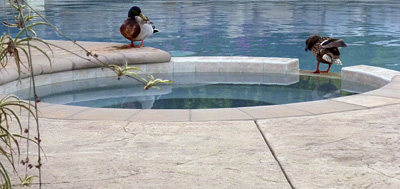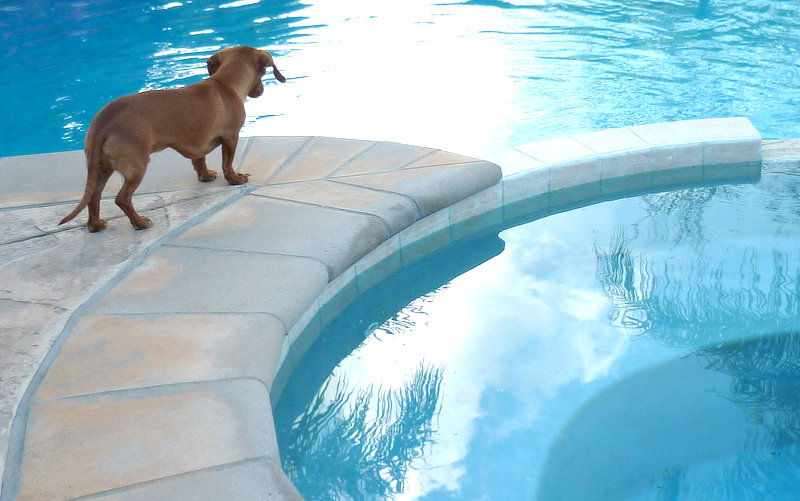Drinking Swimming Pool Water in an Emergency | Safe To Drink?
You may be surprised to discover how many residential swimming pools there are. Just for fun, open up Google Earth and zoom into your neighborhood and see how many pools are around you. City dwellers probably won’t see many, but many parts of suburbia are dotted with pools.
I originally wrote this article way back during the early days of this blog. It has always been a popular hit on internet searches for this general question. So I thought I would update it to an extent.
According to the National Swimming Pool Foundation there are approximately 10 million Swimming Pools in the United States.
There are about 6 million in-ground pools and 4 million above-ground pools based on percentages discovered in a pool marketing report.
According to U.S. Census Bureau statistics there are about 105 million households in the United States. So, on average, there is one swimming pool for every 10 households in America.
The statistics listed above are approximately 10 years old as of this update. However I’m sure that it’s still very close today.
The average size in-ground swimming pool holds about 20,000 gallons of water. The average size above-ground swimming pool holds about 10,000 gallons of water.
How Much Water In Swimming Pools?

That’s approximately 160 billion gallons of water stored in swimming pools across America – the equivalent of 1,500 gallons of water for every household in America. To put it in perspective, that’s theoretically enough water to sustain each household with 4 gallons of water per day for a year.
The notion of relying upon swimming pool water for a backup source has flaws and caveats. City dwellers will not find many residential pools nearby. Swimming pools are more concentrated in geographical areas with a hotter climate. They are more often found in areas where people can afford the luxury. Additionally, one cannot assume that all swimming pools have been treated such that it’s safe to drink pool water…
But, as you can see there is quite a resource of water available in many locations. Enough to ‘get by’ during a disaster that brings down the municipal water supply, or power grid shutting down everything including all well-pumps.
Are Drinking Pool Water Dangers Overblown?
Drinking swimming pool water can (potentially) be safe in an emergency, but not particularly recommended in general.
That said, most swimming pools are maintained and treated properly for it to be technically safe to drink. Years ago I had a in-ground swimming pool where I used to live. I maintained it perfectly and it could have been used as a backup if needed. Here’s what one commenter here had to say:
The dangers of drinking pool water are often blown out of proportion. I’ve owned and maintained an in-ground pool for 40+ years, and am a facility engineer specializing in ultra-pure water production for the semiconductor industry.
~Ron S.
Four years ago I bought my current home, with an in-ground 12,000 gallon pool, which I filled at that time and have had no issues with. I maintain the chlorine content at ~3 ppm, the same as my municipal water supply. I maintain the pH at 7.4, slightly below my tap water which is 7.8. A large cartridge filter takes care of the rest.
I’ve seldom if ever needed shock, have not added stabilizer, salt, or biocide. The only thing that would give me some pause is the elevated mineral content, since water evaporates constantly and leaves the dissolved minerals behind.
Personally, I would not hesitate to drink this water “as is” in an emergency, and honestly I have done so inadvertently more times than I can remember with no ill effects.
Of course, lack of daily circulation will cause fairly rapid degradation without some sort of action on the owner’s part. This would include continued chlorination as needed, with manual agitation. Also, putting on the cover would be wise.
Using something like a Lifestraw, the similar Sawyer product, or even better a Berkey water purifier (which can remove viruses, plus bacteria and protozoa) would add another layer of protection.
Given the choice and depending on the length of time a particular emergency might manifest, dedicated potable water storage would be the preferred solution. Still, in a pinch, I most certainly would not write off the reservoir in the backyard…
Drinking Pool Water | Cautions
If you know what’s in your own pool water, then you know. But if you’re thinking about your neighbor’s pool water, you don’t know.
Some things in that water may not be good for you if there’s “too much” of it.
Too much chlorine (greater than 4 ppm not recommended for drinking). 3 ppm or less, okay. You can easily test this with chlorine test strips.
(recommended test strips on amzn)
Bromide in the water. This is an alternative that some use for sanitizing pools.
Cyanuric acid. It’s a chlorine stabilizing agent sometimes used by pool owners.
Salt water pools. Some pools have a salt chlorination system which converts salt to chlorine. It’s not recommended to drink salt water.
Algae. The water will rapidly turn green if not treated properly.
Drinking Pool Water in Emergency | Recommendations
If you are going to consider drinking pool water in an emergency, consider the following:
Pool Cover | Tarp
Hot and Sunny conditions will degrade chlorine levels quickly. A pool that sits idle without chlorine replenishment or filtration will begin to grow organic algae.
The degradation process will be minimized by covering the water, blocking the sunlight. Some pool owners already have covers. But if you don’t, try using a big tarp during the event. A cover will help keep sunlight from breaking down the existing chlorine in the water.
Supply of Chlorine & Test Kit
The chlorine in swimming pools will break down fairly quickly when exposed to the Ultraviolet UV rays from the sun. Normally, the chlorine level of a properly maintained pool is kept at about 3 ppm (parts per million).
Check this, and other levels, with a multi-functional swimming pool test kit.
Keep a supply of chlorine. I always liked the tablets in a floater dispenser.
Water Purifier Filter
It’s also a great idea to filter the water with a quality drinking water filter. This will remove bacteria and organic pathogens, and will make it taste better.
One of the highest quality drinking water filters I have found, is the Berkey water filter system. I’ve used the Berkey for over a decade. All of our daily drinking water goes through it. If you’re ever considering one, I highly recommend using this particular authorized distributor, USA Berkey Filters.
If the swimming pool is being used as an emergency water source during a disaster, and the water is becoming green with algae, this filter will remove it, along with bacteria and virus.
Pool Water May Be Reasonably Safe, But…
In summary, it may be reasonable to use pool water as a drinking source if it was (is) well maintained, properly and safely treated, and for extra protection – filtered through a quality drinking water filter.
Note that unless the pool is your own, you will not know what someone else may have put in their pool besides chlorine. I’m certainly not advising that all swimming pools are safe to drink from. Although when you think about it, how many people end up inadvertently drinking gulps of water from a pool – and surviving just fine… When’s the last time you heard of someone keeling over sick because they drank water from their swimming pool? That’s what I thought – probably not…
The “But”
With all of that said, I recommend that pool water be utilized for “gray water” uses. Sanitation, flushing toilets without electricity, cleaning, etc.. during an emergency.
It’s better to have a unique plan and method for safe drinking water and water storage that you know will not have other chemicals in it besides safe levels of chlorine.
Continue reading: How To Make Drinking Water Safe With Bleach

